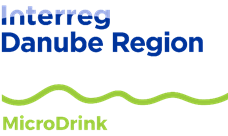Microplastics in the Danube region
MicroDrink project examines groundwater and drinking water
The Danube region includes 19 countries with over 80 million inhabitants who, like all people, depend on clean drinking water. The entry of microplastics into groundwater and drinking water is receiving particular attention in a current, cross-border project.
The Interreg Danube MicroDrink project aims to develop the basis that enables to assess the occurrence of microplastics in groundwater and drinking water. As a project partner, Umweltbundesamt – Environment Agency Austria provides important expertise on sampling and analysis in order to develop harmonized methods.
The starting signal for the project was a kick-off meeting with the project partners, which took place from March 6th to 8th, 2024 in Zagreb, under the leadership of the Croatian Geological Survey. Over the next two and a half years, 31 partners from Croatia (lead), Germany, Austria, Slovenia, Hungary, the Czech Republic, Serbia and Bosnia-Herzegovina will dedicate themselves to exchanging knowledge and experience regarding sampling, analytics, monitoring and risk assessment. In Austria, in addition to the Environment Agency Austria, the state of Carinthia and the Ministry of Health and Agriculture are involved.
The collaboration between eight countries makes a significant contribution to sampling and analyzing microplastics in drinking water using standardized methods in order to compare the data.
Carinthia case study
As part of the project, the current state of science is to be recorded, an inventory of national case studies in the eight countries is to be carried out and the basics of risk assessment are to be discussed. In Austria, the Environment Agency Austria and the state of Carinthia work together. Suitable measuring points in a karst groundwater body are will be selected, samples will be taken and analyzed using different methods and last but not least potential entry paths will be identified. The method comparison and other findings will flow into the project's knowledge base and will be disseminated as part of recommendations, workshops and training courses.
Starting point: EU Drinking Water Directive
The revised EU Drinking Water Directive (RL (EU) 2020/2184) (EU DWD) has added microplastics to the watch list to examine the effects of novel substances on human health and stipulates that a suitable sampling and analytical method for measuring microplastics must be determined. A full risk assessment should be carried out by 2029. The prerequisite for this is the development and acceptance of harmonized sampling and analysis methods.
Environment Agency Austria and microplastics studies
The Environment Agency Austria has been investigating microplastics in various environmental media for around 10 years, especially in surface waters such as the Danube or the rivers in Carinthia. The occurrence of microplastics in soil and sewage sludge was also the focus of research projects. Furthermore, the experts analyzed microplastics in textiles and table salt. As part of human biomonitoring, microplastics were detected in human stool for the first time in 2018 as part of an international pilot study.
Links:



